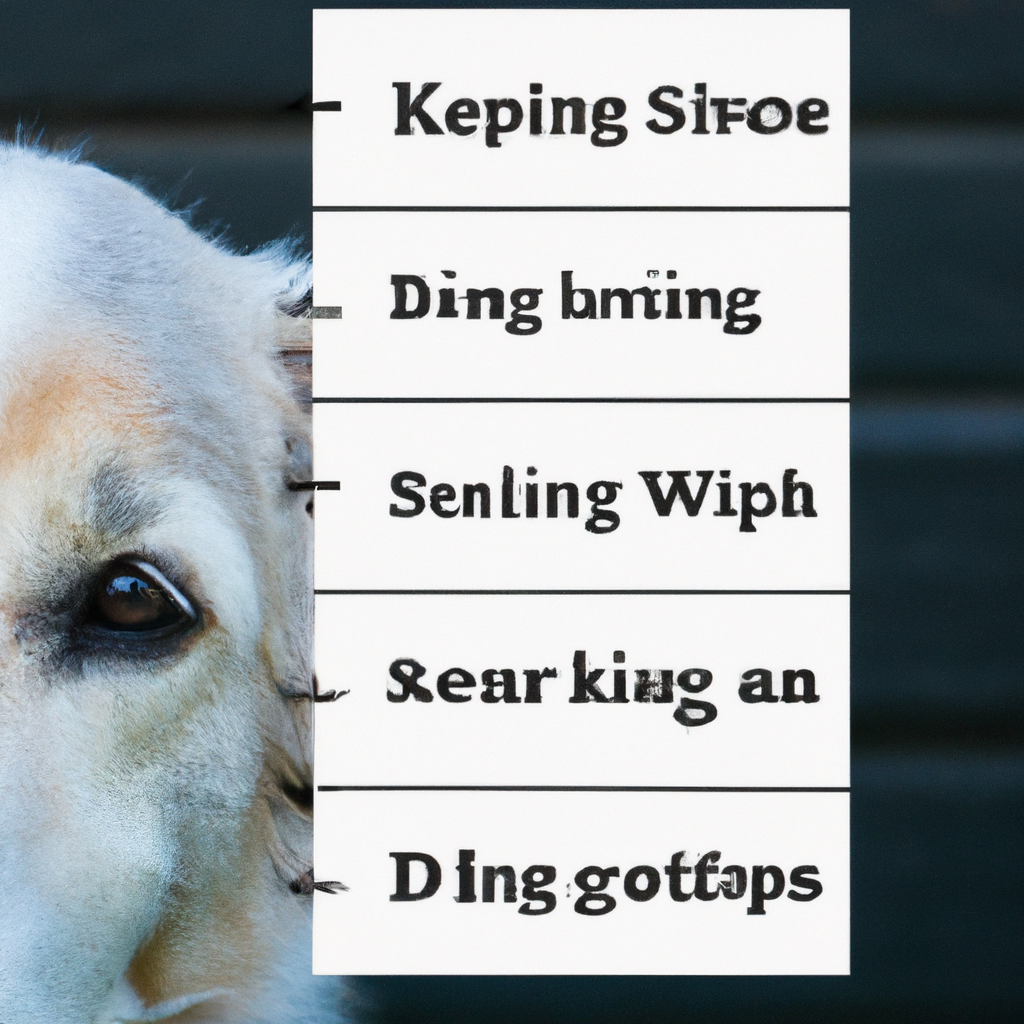Managing Allergies in Dogs: Causes, Symptoms, and Treatment
As the autumn breeze rustles through the trees, dogs all over the world begin their battle against allergies. From

As the seasons change, nature adds vibrant hues to its canvas, spreading joy and excitement throughout. But for some, these seasons come with an unwelcome guest: allergies. It’s not just us humans who suffer from watery eyes and sneezing fits; our beloved canine companions often face their own battle with allergic reactions. While our faithful friends may not be able to communicate their discomfort through words, it is our duty to understand and manage their allergies effectively. This article delves into the perplexing world of allergies in dogs, exploring their causes, symptoms, and treatment options, offering a guiding hand for pet owners seeking to ensure their furry friends continue to live their best, sniffle-free lives.
Understanding Canine Allergies: Unraveling the Causes, Triggers, and Breeds Most Affected
Causes of Canine Allergies:
Allergies in dogs can be caused by a variety of factors, including genetic predisposition, environmental allergens, and food sensitivities. Some dogs may be genetically more prone to developing allergies, with certain breeds having a higher susceptibility. Environmental allergens such as pollen, dust mites, and mold spores can trigger allergic reactions in dogs, just like in humans. Additionally, certain ingredients in dog food, such as wheat, soy, or beef, can also cause allergic reactions in sensitive canines. Identifying the underlying cause of a dog’s allergy is crucial in managing and treating their symptoms effectively.
Common Allergy Triggers:
Dogs can have allergic reactions to a wide range of substances that are commonly found in their environment. Some of the most common triggers include pollen, grass, mold, dust mites, certain types of fabrics, and even flea bites. These allergens can cause various symptoms in affected dogs, including itching, sneezing, coughing, skin rashes, and digestive issues. It’s important for dog owners to be observant and take note of any recurrent patterns or triggers that may be causing their pet’s discomfort. This information can help both the owner and the veterinarian to develop an effective treatment plan tailored to the dog’s specific needs.

Spotting the Telltale Signs: Common Symptoms of Allergies in Dogs
Our furry friends can suffer from allergies too! Just like humans, dogs can experience uncomfortable allergic reactions to certain foods, environmental factors, or even fleas. As pet owners, it’s crucial to be able to recognize the common symptoms of allergies in our canine companions. By paying attention to these telltale signs, we can quickly seek the appropriate treatment and ensure our furry friends live their happiest, healthiest lives.
Symptoms to Look Out For:
- Relentless Itching and Scratching: Dogs with allergies often exhibit excessive scratching, biting, or licking particular areas of their body, such as their paws, ears, or groin, leading to irritated skin or hot spots.
- Chronic Ear Infections: The presence of allergies can trigger recurrent ear infections in dogs. If your four-legged friend constantly shakes their head, scratches their ears, or emits a foul odor, it may be a sign of an allergic reaction affecting their ears.
- Red and Watery Eyes: Allergic reactions can cause dogs to develop watery, red, or swollen eyes, similar to human eye allergies. If you notice your canine companion exhibiting discharge or excessive eye rubbing, it’s time for a visit to the vet.
- Sneezing and Nasal Discharge: Just like humans, dogs may experience sneezing fits and nasal congestion when exposed to allergens. If your dog suddenly develops a runny nose or starts sneezing frequently, allergies might be the culprit.
In conclusion, being aware of the common symptoms associated with allergies in dogs empowers us to take appropriate action and provide the necessary care. While an occasional sneeze may not be cause for alarm, persistent and severe symptoms warrant a visit to your veterinarian. Remember, understanding the signs of allergies in our furry companions allows us to advocate for their well-being and ensure they enjoy a happy, comfortable life free from allergic discomfort.

Nurturing Your Four-Legged Friend: Effective Treatment and Management Strategies for Canine Allergies
When it comes to our beloved four-legged friends, ensuring their health and well-being is of utmost importance. Canine allergies can cause discomfort and distress for dogs, and as responsible pet owners, it is crucial to be equipped with effective treatment and management strategies. Here are some creative ways to nurture and support your furry companion:
- Identify the allergen: The first step in tackling canine allergies is to identify the specific allergen triggering the reaction. Common allergens include pollen, dust mites, certain foods, or even specific materials such as wool. Consult with your veterinarian to perform necessary tests and determine the root cause.
- Offer a balanced diet: A well-balanced diet plays a vital role in maintaining your dog’s overall health and reducing allergic reactions. Opt for high-quality, hypoallergenic dog food that excludes potential allergens. Incorporate Omega-3 fatty acids, which have anti-inflammatory properties, into their diet through fish or flaxseed oil supplements.
- Pamper their paws: Allergens often make their way into your home through your dog’s paws. Wipe their paws with pet-friendly wipes after walks to minimize exposure to potential allergens. Regularly check for any irritations or redness between their toes, as this may indicate an allergic reaction.
- Create a safe haven: Designate a hypoallergenic zone in your home, such as a specific room or an elevated bed, where your dog can retreat and find relief from allergens. Use hypoallergenic bedding materials and ensure proper ventilation to minimize airborne allergens.
Remember, each dog is unique, and what works for one may not work for another. It is essential to consult with your veterinarian to tailor an effective treatment and management plan that suits your dog’s specific needs. By nurturing and supporting them through their allergies, you can ensure a happier and healthier life for your four-legged friend!
To Conclude
As we navigate our way through the intricate world of our furry friends, it becomes increasingly important to understand the nuances of their health and well-being. We have delved into the realm of managing allergies in dogs, unraveling the intricate tapestry that binds causes, symptoms, and treatment together. Now armed with knowledge, we embark on a journey to better champion the health of our beloved four-legged companions.
From environmental factors to genetic predispositions, allergies in dogs can originate from myriad sources, forever reminding us of their unique biological makeup. By decoding the prime suspects and regular culprits, we gain a clearer understanding of the triggers that leave our furry companions scratching their innocent noses. Armed with this knowledge, we are better equipped to shield them from potential allergens lurking in their daily surroundings.
Within the intricate web of symptoms lies the breadcrumbs leading us to a diagnosis of our canine companions’ allergies. From constant itching and excessive shedding to irritated skin and recurrent ear infections, these signs serve as red flags, urging us to take action and provide the necessary relief to our suffering companions. By becoming attuned to these signals, we become their greatest advocates, ensuring comfort and relief in their every wag of the tail.
Treatment becomes the lighthouse guiding us through the turbulent sea of allergies. Consulting with veterinarians, we stumble upon a plethora of solutions, each tailored to address the specific needs of our dear companions. Be it medications, specialized diets, or the potential for immunotherapy, we are presented with an array of paths that lead to the restoration of their vibrant energy and undeniable zest for life.
As our journey at unraveling the secrets of managing allergies in dogs comes to an end, we are left with a profound sense of responsibility. With knowledge and awareness, we wield the power to alleviate the suffering of our four-legged companions, providing them with a life free from the shackles of allergies. Let this knowledge be our guiding compass, fueling our commitment to safeguard their well-being and embark on this wondrous adventure of warmth, companionship, and unwavering love.






